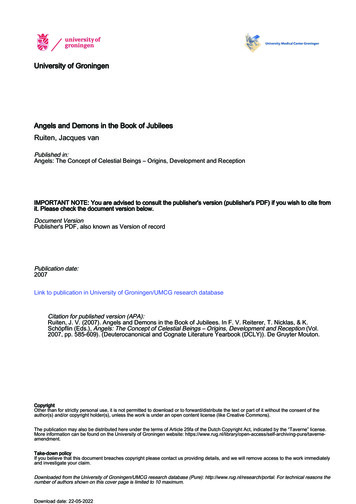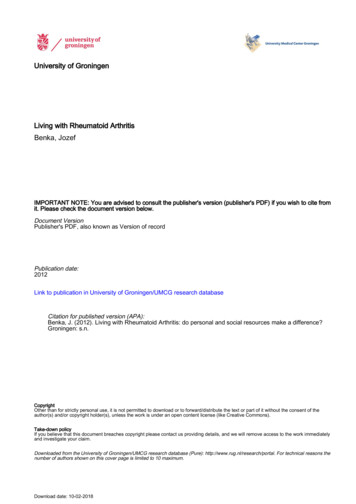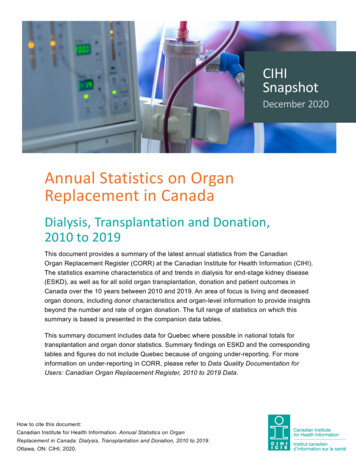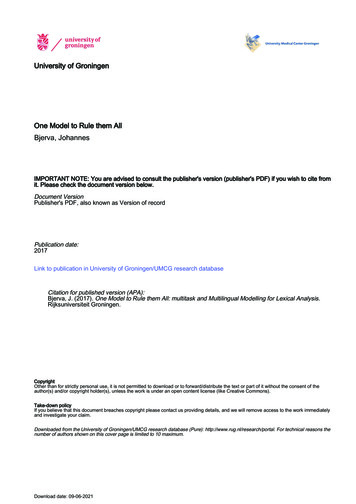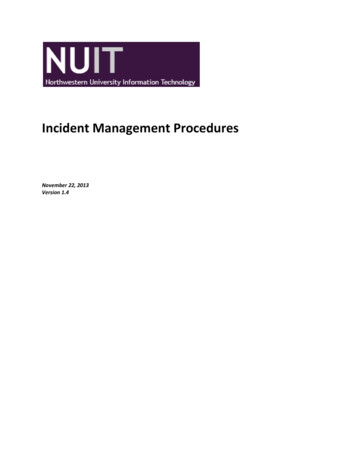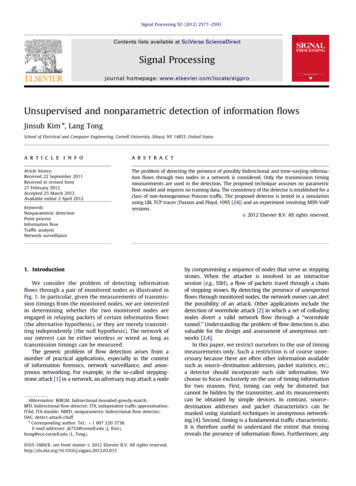
Transcription
University of GroningenEnd-organ damage in diabetesHamidi Shishavan, MahdiIMPORTANT NOTE: You are advised to consult the publisher's version (publisher's PDF) if you wish to cite fromit. Please check the document version below.Document VersionPublisher's PDF, also known as Version of recordPublication date:2015Link to publication in University of Groningen/UMCG research databaseCitation for published version (APA):Hamidi Shishavan, M. (2015). End-organ damage in diabetes: Exploring innovative targets and therapies.University of Groningen.CopyrightOther than for strictly personal use, it is not permitted to download or to forward/distribute the text or part of it without the consent of theauthor(s) and/or copyright holder(s), unless the work is under an open content license (like Creative Commons).The publication may also be distributed here under the terms of Article 25fa of the Dutch Copyright Act, indicated by the “Taverne” license.More information can be found on the University of Groningen website: ing-pure/taverneamendment.Take-down policyIf you believe that this document breaches copyright please contact us providing details, and we will remove access to the work immediatelyand investigate your claim.Downloaded from the University of Groningen/UMCG research database (Pure): http://www.rug.nl/research/portal. For technical reasons thenumber of authors shown on this cover page is limited to 10 maximum.Download date: 24-05-2022
Baseline Intrarenal Artery Function Predicts Proteinuria in Diabetic ZDF RatsChapter 1General introduction9
INTRODUCTIONRegulation of blood glucose levels is of paramount importance to human physiology.Normally, blood glucose level is tightly regulated as a part of metabolic homeostasis. Whenblood glucose falls below a certain level, the body starts to use stored sugar as an energysource through glycogenolysis, and converses stored glycogen in the liver and muscle toglucose, which can then be utilized as an energy source. Conversely, when blood glucoseexceeds the normal level, the excess glucose (which otherwise would be toxic) is removedfrom the blood by the action of insulin, a peptide hormone produced by beta-cells of thepancreas. Key mechanisms dispatching the action of insulin consist of the promotion of theuptake of glucose in skeletal muscle and fat tissue and of shifting metabolism towards fatstorage rather than fat utilization for energy.When regulatory mechanisms fail to adequately maintain blood glucose within the normalrange, conditions of abnormally diminished (hypoglycemia) or excessive (hyperglycemia)blood glucose levels occur producing a variety of symptoms. Hypoglycemic symptoms andmanifestations are related to the actions produced by counter regulatory hormones(adrenaline and glucagon) triggered by the falling glucose level (e.g. shakiness, anxiety,tachycardia, sweating, hunger, nausea, headache, etc.), and the neuroglycopenic effects bythe reduced brain glucose level (e.g. mental abnormalities and personality change, fatigue,weakness, blurred/double vision, lack of coordination, etc.). Brain effects can range frommild dysphoria to serious seizures and unconsciousness. In contrast, when temporary,hyperglycemia is often benign and asymptomatic. Blood glucose levels can rise well abovenormal for significant periods without producing any obvious effects or symptoms.However, chronic hyperglycemia at levels more than slightly above normal may produce awide variety of serious complications over a period of years. When the glucoseconcentration in the blood remains high over time, the kidneys will reach a threshold ofreabsorption, and glucose will be excreted in the urine (glycosuria). This increases theosmotic pressure of the urine and inhibits reabsorption of water by the kidney, resulting inincreased urine production and increased fluid loss. The decrease in blood volume iscompensated by water held in body cells and other body compartments, causingdehydration and thirst. Consequently, the classical symptoms of hyperglycemia, next topolyphagia, are polydipsia and polyuria.
IntroductionChronic hyperglycemia that persists even during fasting defines a state referred to asdiabetes mellitus (DM). DM is due to insufficient production of insulin by the pancreas, orby insensitivity of body cells to the action of insulin. There are three main types of DM. (i)Type 1 diabetes mellitus (T1DM) results from the body's failure to produce sufficientamounts of insulin, the cause of which is unknown. This form was previously referred to as"insulin-dependent diabetes mellitus" (IDDM) or "juvenile diabetes". (ii) Type 2 diabetesmellitus (T2DM) starts with a condition in which cells fail to respond to insulin properly,termed "insulin-resistance". As the disease progresses insufficient production of insulinmay also develop due to beta cell exhaustion. This form was previously referred to as "noninsulin-dependent diabetes mellitus" (NIDDM) or "adult-onset diabetes". (iii) Gestationaldiabetes is the third main form occurring in pregnant women, who develop increased levelsof blood glucose without a previous history of diabetes. During pregnancy, the placenta,which connects baby to mother blood supply, produces high levels of various hormoneswhich impair the action of insulin in the mother. Gestational diabetes usually developsduring the second half of pregnancy.Trends in obesity, metabolic syndrome and T2DM leading to cardiovascular diseaseIn 2011, according to International Diabetes Federation, an estimated 366 million peopleword wide had diabetes, with type 2 making up the majority of the cases. Its prevalence isincreasing rapidly and is estimated to be almost doubled by 2030 [1]. Diabetes occursthroughout the world, but is more common (especially type 2) in the more developedcountries. However, the largest increase in prevalence is expected to occur in Africa, wherethe incidence is predicted to be amongst the highest by 2030 [2]. The increase in incidencein developing countries follows the trend of urbanization and lifestyle changes, perhapsmost importantly a "Western-style" diet. This has suggested an environmental (i.e., dietary)effect although there is little understanding of the mechanism(s) at present. However,striking similarities have been observed between epidemic increases in overweight andobesity with the profound increases in DM in recent decades. Overweight goes hand inhand with the development of T2DM. People who are overweight are at much greater riskof developing T2DM than individuals with normal weight. In fact, obesity is at thebackground of the risk of developing T2DM [3].111
Chapter 1It is well known that obesity commonly coexist with insulin resistance, although causallinks between insulin resistance, obesity, and dietary factors are complex and controversial[3]. It is possible that one of them arises first, and tends to cause the other; or that insulinresistance and excess body weight might arise independently as a consequence of a thirdfactor, but end up reinforcing each other. Some population groups might be geneticallypredisposed to one or the other. Central obesity is the principal symptom of what is referredto as "metabolic syndrome" (MetS), a disorder of energy utilization and storage also knownas (metabolic) syndrome X, cardiometabolic syndrome and Reaven's syndrome, amongstothers. MetS is diagnosed by a co-occurrence of three out of five of the following medicalconditions: abdominal (central) obesity, elevated blood pressure, elevated fasting plasmaglucose, high serum triglycerides, and low high-density cholesterol (HDL) levels [4]. Riskfactors of MetS include, but may not be restricted to, stress, overweight and obesity,sedentary lifestyle, Western dietary pattern, hyperphagia and ageing.Crucially, however, MetS markedly increases the risk of developing DM andcardiovascular disease (CVD). MetS and DM are associated with dyslipidemia which isalso a risk factor for CVD. Dyslipidemia is associated with impaired carotid arteryelasticity, intima-media thickness and brachial flow-mediated dilatation [5]. Atheroscleroticplaque is associated with the elevation of non-high density lipoprotein cholesterol [6]. Asdyslipidemia develops the number of risk factors and severity of asymptomatic coronaryand aortic atherosclerosis increases. In addition, DM itself is suggested to be aninflammatory disease and important risk factor for CVD as statistics indicate a strongcorrelation between CVD and DM. Hence, adults with DM are more likely to have heartdisease or stroke than adults without DM [7]. Heart diseases and stroke actually are thenumber 1 causes of death and disability among people with T2DM. In fact, a considerablepercentage of people with DM do not die of DM itself but of some form of hypertension,heart disease or stroke! [7]. As highlighted later on in this thesis, we believe that thisimportantly involves the effect of DM attenuating vascular function.The diabetes epidemic is an epidemic of diabetic micro- and macrovascularcomplications12
IntroductionIn the United States alone, nearly 174 million people have undiagnosed DM, as delineatedfrom over 744 reviewed data sources [8], but at the same time are at great risk to developend-organ damage and die from CVD. There is consensus that key to the increased1mortality are the changes in micro- and microvasculature.Atherosclerosis is a main consequence of macrovascular disease in DM. Narrowing andstiffing of arterial walls throughout the body - which is formed by the build-up of fats,cholesterol and other substances in and on the arteries walls (plaques) - can restrict bloodflow. These plaques may burst and trigger the formation of blood clots and heart problems[9,10].People with DM may experience damage to micro vessels and nerves, e.g. in the back ofthe eye leading to diabetic retinopathy, a condition of eye problems that may includereduced vision [11]. Indeed, DM is the main cause of acquired blindness in people underthe age of 65 and is one of the leading causes in older adults. DM may also cause damageto micro vessels in the kidney leading to diabetic nephropathy and the attenuation of kidneystructure and function. This can progress to a devastating disease: kidney failure. Treatmentof kidney failure requires dialysis or transplantation. These procedures are a burden topatients and society. Hence, DM is the main reason for Americans to be dialyzed.Furthermore, chronic kidney disease per se is a risk factor for CVD thereby furthercontributing to the high incidence of cardiovascular mortality in DM [12,13].Diabetes also may damage the peripheral nervous system innervating the arms and legs.Affected patients experience pain, and tingling or buzzing sensations in their hands and/orfeet. Patients may lose bladder control, or the ability to walk, and males show loss of abilityto function sexually (impotence or erectile dysfunction) [14]. Other complications of DMinclude diabetic dermopathy and cognitive disturbances. Nevertheless, the majority of DMpatients develop micro- and macrovascular disease and die from CVD.13
Chapter 1Figure 1. By increasing metabolic syndrome and diabetic mellitus, the complications of micro- and macrovascular dysfunction and end-organ damage raises significantly.Prevention and treatment of diabetes: current measures and limitationsThe above may be summarized in a scheme of conditions in which micro- andmacrovascular disease associated with or resulting from DM leads to development of endorgan damage and death from CVD: see Figure 1. Of note in this scheme are the initialconditions in MetS which precede and feed the development of DM, and the notion thatinitial overweight/obesity at the start of the scheme currently is a growing global issuereaching epidemic proportions. The consequence hereof is a threatening revival ofpremature CVD-morbidity and -mortality worldwide, and an associated rise in economic(health care) costs. The current diabetes treatments indeed improved general complications14
Introductionbut still not enough to halted and reversed the complications of CVD-events. Hence, toimprove diabetes outcome nowadays necessitates both the prevention of (epidemic) DM2and development of adequate strategies coping with its consequences.The main measure to prevent development of DM consists of life-style changing measuresto prevent initial conditions (of MetS) leading hereto (Figure 2). These consist of changinga diabetic prone lifestyle such as decreased physical activity and replacing the ‘Westerntype diet’ of high fat food, refined sugar and excessive processed red meat with a high fiberand green diet. In addition, proper pharmacological treatments are needed to control thecondition of per se DM and its consequences: the anti-diabetic drugs (Figure 2). Currentpharmacological interventions that have been developed in recent years are aimed atcontrolling plasma glucose levels either by inhibition of gluconeogenesis or increasing thelevels of insulin or improving the body's sensitivity to insulin. Nowadays a range of antidiabetic medicines are clinically available, including insulin, sulfonylureas, disaccharidaseinhibitors, thiazolidinediones, meglitinides, GLP analogs, amylin analogs and DPP-IVinhibitors which can be used alone or in combination of together [15].Unfortunately, the effectiveness of lifestyle changes to prevent DM are not alwayssuccessful. This may be due both to poor compliance but also a lack of knowledgeregarding specific gene-environment interactions that predispose to DM. Hence, we do notalways know which individuals are more at risk of developing DM as compared to others,meaning that "standard" lifestyle changing programs may "work" for some in the generalpopulation but not all. Such programs could be more successful when focused on (groupsof) individuals who are more likely (i.e. at risk) to enter the obesity-MetS-DM sequel orsuffer its consequences to a higher extent (i.e. a higher degree of mirco- and macrovasculardisease and end-organ damage than others). Such (groups of) individuals could be morespecifically targeted at an earlier stage, were it not that these individuals are insufficientlyidentified at present.In a similar way, not all of the currently available anti-diabetic drugs actually are successfulin all DM patients. Some anti-diabetic drugs seem to provide less CVD-benefit than wouldbe expected based on their ability for glycemic control. Vice versa, other treatments seemto provide protection against end-organ damage in DM that goes beyond glycemic control,but via mechanisms and targets which are largely unknown.151
Chapter 1Figure 2. Current measures to prevent diabetes include a change in sedentary life-style and dietary patterns next tothe anti-diabetic treatments that aim to control hyperglycemia.A chance for innovative targets and therapiesThus besides (1) preventing diabetes and (2) treating its symptoms, discomforts and lifethreats directly associated with hyperglycemia as in current approaches, additionalimportant goals include (3) a better identification of (groups of) individuals who are athigher risk of developing DM or more severely suffering its consequences and (4) the perse prevention of end-organ damage in DM.(ad.3) Individual susceptibility to end-organ damage is largely variable anyhow, evenamong seemingly similar (normal healthy) individuals. The possibility to identify those16
Introductionindividuals who are at a risk of developing a higher degree of end-organ damage when DMdevelops would provide additional options for 'personalized medicine' at an early stage.Variability in vascular function among subjects at apparent normal health could be such anidentifier of an individual's susceptibility to end-organ damage but this has not yet beenstudied in subjects prone to develop MetS and DM. If so, however, vascular function wouldbe an important pharmacological target, both in pre-DM (i.e. to reduce initial susceptibilityto end-organ damage in DM) and in DM-conditions (i.e. to inhibit the progression ofexisting end-organ damage).(ad.4) The per se prevention of end-organ damage in DM further implies that a potentialdirect protective (i.e. pleiotropic) effect of an anti-diabetic compound against end-organdamage is as relevant as its property (by definition) to control hyperglycemia. Such effectsmay include actions on yet unidentified targets but which bear significant relevance to endorgan damage in DM. Taken together, the above provides relevant opportunities forinnovative new targets and therapies, as summarized in Figure 3.171
Chapter 1Figure 3. Maintaining the integrity of vascular function can should be considered an important target for MetS andDM treatment.Targets and treatments explored in this thesisThe aim of this thesis was to explore new targets and therapies to prevent end-organdamage in diabetes. To this end we focused on:1.vascular function as a predictor of individual susceptibility to end-organ damage insubjects prone to develop DM,2.key mechanisms of end-organ damage in DM as potential new targets of therapy,3.pleiotropic vascular/hemodynamic effects of existing anti-diabetic agents andpromising non anti-diabetic agents.18
IntroductionAd.1 To address the above we first employed the obese Zucker diabetic fatty rat (ZDF)model of end-organ injury and function loss in DM in Chapters 2 and 3. In Chapter 2 theaim was to study the predictive value of intra-organ vessel function for an (normal?)individual's susceptibility to develop end-organ damage in DM. To this end, intra-renalvascular function was assessed in young ZDF when still at pre-diabetic state and withoutrenal damage. Individuals were then followed over time for urinary protein excretion andglomerulosclerosis as indices of renal injury during DM development, and correlated thiswith intra-renal artery function at baseline.Ad.2 The ZDF model was also used for the studies of brain damage in DM. Proteinaggregate formation is a common feature of neurodegenerative diseases leading toneurofibrillary tangle formation with cognitive deficits. In Chapter 3, we studied thepresence of protein aggregation in the frontal brain of ZDF with aim to identify keymechanistic targets. Given their roles in proteostasis and brain anti-oxidant formation,respectively, we focused on the mTOR-pathway and H2S producing enzyme cystathioninebeta synthase (CBS).Ad.3 Endothelial dysfunction has emerged as a target for primary prevention strategies inCVD. It has been suggested that certain anti-diabetic drugs - e.g. metformin - providecardiovascular benefit beyond glycemia control, possibly via a (glucose-independent) directeffect on vascular function. In Chapter 4 we used spontaneously hypertensive rats (SHR) a model of endothelial dysfunction in a setting of HT - to further investigate this.Endothelium-dependent relaxation was studied in aortas of SHR with and withoutstreptozotocin-induced type 1 DM (T1DM) after long-term treatment with metformin orvildagliptin. Finally in Chapter 5 we studied the vascular treatment effects of FTY720(fingolimod). Interest in this novel immunomodulator for treatment of T1DM has increasedrecently. FTY720 suppresses the immune response by sequestering circulating maturelymphocytes from the blood and peripheral tissues to secondary lymphoid tissues and thethymus. It has been suggested that similar mechanisms may help to protect islet beta cellsfrom autoimmune destruction at an early stage of DM. First results in animal studies arepromising but whether this might involve potential effects of FTY720 via modulation ofvascularS1Preceptorfunctionisunknown.191
Chapter 1References1. Alam U, Asghar O, Azmi S, Malik RA. Chapter 15 - general aspects of diabetes mellitus.In: Anonymous Handbook of Clinical Neurology. : Elsevier. pp. 211-222.2. Wild S, Roglic G, Green A, Sicree R, King H. Global prevalence of diabetes: Estimatesfor the year 2000 and projections for 2030. Diabetes Care. 2004;27: 1047-1053.3. Sesti G. Pathophysiology of insulin resistance. Best Practice & Research ClinicalEndocrinology & Metabolism. 2006;20: 665-679.4. Reaven GM. The metabolic syndrome: Is this diagnosis necessary? The AmericanJournal of Clinical Nutrition. 2006;83: 1237-1247.5. Niu L, Zhang Y, Qian M, Meng L, Xiao Y, Wang Y, et al. Impact of multiplecardiovascular risk factors on carotid intima-media thickness and elasticity. PLoSONE. 2013;8: e67809.6. Taskinen M, Borén J. New insights into the pathophysiology of dyslipidemia in type 2diabetes. Atherosclerosis. 2015;239: 483-495.7. Vazquez-Benitez G, Desai JR, Xu S, Goodrich GK, Schroeder EB, Nichols GA, et al.Preventable major cardiovascular events associated with uncontrolled glucose, bloodpressure, and lipids and active smoking in adults with diabetes with and withoutcardiovascular disease: A contemporary analysis. Diabetes Care. 2015.8. Beagley J, Guariguata L, Weil C, Motala AA. Global estimates of undiagnosed diabetesin adults. Diabetes Res Clin Pract. 2014;103: 150-160.9. Bays HE. Lowering low-density lipoprotein cholesterol levels in patients with type 2diabetes mellitus. International Journal of General Medicine. 2014;7: 355-364.10. Yuan S, Liu Y, Zhu L. Vascular complications of diabetes mellitus. Clinical andExperimental Pharmacology and Physiology. 1999;26: 977-978.11. Sayin N, Kara N, Pekel G. Ocular complications of diabetes mellitus. World Journal ofDiabetes. 2014;6: 92-108.12. Goldfarb-Rumyantzev AS, Rout P. Characteristics of elderly patients with diabetes andend-stage renal disease. Semin Dial. 2010;23: 185-190.13. Wang Ay. Cardiovascular risk in diabetic end-stage renal disease patients. Journal ofDiabetes. 2011;3: 119-131.20
Introduction14. Albers J, Pop-Busui R. Diabetic neuropathy: Mechanisms, emerging treatments, andsubtypes. Current Neurology and Neuroscience Reports. 2014;14: 1-11.15. Goldman-Levine JD. Combination therapy when metformin is not an option for type 2diabetes. Annals of Pharmacotherapy. 2015.211
Gestational diabetes usually develops during the second half of pregnancy. Trends in obesity, metabolic syndrome and T2DM leading to cardiovascular disease In 2011, according to International Diabetes Federation, an estimated 366 million people word wide had diabetes, with type
